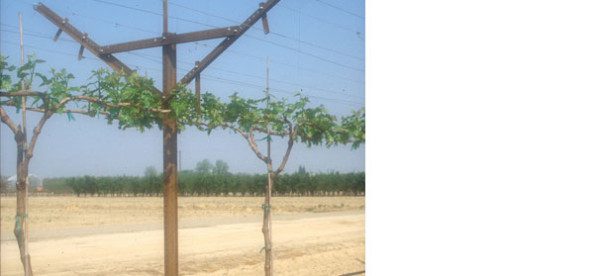
Feb 20, 2013Growers experiment with dried-on-the-vine raisins
When dried-on-the-vine (DOV) grapes were first introduced to California growers several years ago, it seemed like a win/win situation. Instead of cutting clusters of grapes and leaving them to dry on trays on the ground, growers could cut the vines and let them hang on the trellises to dry.
There were several problems with DOV in California, however. One is that open-gable trellis systems were used on Thompson seedless grapes, which have traditionally been used to make raisins in California. DOV on open-gable trellises, however, was originally designed for Selma Pete and Fiesta grapes in Australia, which ripen earlier than Thompson seedless, said Ron Brase of AgQuest Consulting in Fresno, Calif., who also grows raisins.
Ideally, DOV grapes should be severed no later than Aug. 15, and preferably closer to Aug. 10, if at all possible, Brase said. The problem with Thompson seedless, however, is that they don’t get high enough sugars until the first week of September.
“If you wait that late to sever the canes – if you have an Indian summer, you’ll be OK, but other than that, there’s so much dew forming in October that the raisins become so moist that you’ll need a dehydrator to dry them,” Brase said.
For growers looking to get into DOV, Fiestas or Selma Petes, which can easily be cut on Aug. 1 or Aug. 10, are usually the best varieties to go with, Brase said.
In terms of trellising, there are two basic systems growers can go with: open gable or overhead. In open gable, V-shaped posts – made of treated wood or metal – run down the field. Wires attached on both sides of the V run parallel to the ground. The wires help support the canes. Typically, the width of these trellis systems is 36 to 60 inches, said Stephen Vasquez, a University of California (UC) Cooperative Extension viticulture farm adviser for Fresno County.
In an overhead trellis system, an entire field is completely covered with wires and posts, which crisscross so that all of the rows are completely interconnected. The challenge with overhead (since everything is interconnected) is that the entire system has to be constructed at one time, Brase said.
The advantage of the open-gable system, Brase said, is that instead of installing an entire field at once, growers can construct the trellises one row at a time.
Brase, who has become a fan of open-gable systems, has over the past six years gradually switched out his old Thompson seedless vineyard to Selma Petes, which are more conducive to DOV and open-gable trellising.
“The open-gable system cost about $5,000 per acre (to construct),” Brase said. “So, rather than try to do it all at once and spend $100,000 right away (for an overhead trellis system on an entire field), you can do it a little at a time.”
Harvesting on open-gable systems, as growers discussed at a recent viticulture meeting in Fresno, is still a challenge, although it’s much easier than harvesting on overhead systems.
“It all depends on how wide your wires are,” Brase said. “Custom wine harvesters are already set up to do 48- to 54-inch-wire trellises, so that’s no problem,” Brase said.
Brase likes to grow his grapes on 60-inch wires instead of 54-inch wires, because he gets more yield.
“The harvesters don’t care how many pounds you get per acre, because they’re spending the same amount of time in your fields anyway,” Brase said.
Many growers at the meeting expressed concerns about yield. They had been hoping to get 4 to 4.5 tons per acre with the DOV system. But they found that they were getting 2 tons per acre with Thompson seedless. With Selma Petes, they were getting at least 3 tons per acre, Brase said.
Many growers at the meeting had tried tweaking their DOV Thompson seedless trellising systems to get higher yields – some with more success than others.
Matthew Fidelibus, an association Extension specialist with the department of viticulture and enology at UC Davis, discussed the different types of trellising systems.
“One of the biggest challenges is sustaining yields with them,” Fidelibus said.
The most important part of sustaining yields is making sure that fruiting nodes for the next year’s crop receive enough sun during the growing season. Part of the challenge with this is making sure the current year’s fruiting canes don’t shade out the budding spurs, Fidelibus said.
Vasquez said letting canes grow too long can be a problem, because it means shorter shoots, overcropping and creating canopies so dense that drying the raisins is difficult come harvest time.
The original open-gable system was designed for farmers who were hand cutting and harvesting the raisins, Fidelibus said.
“Now that more people are growing them and using mechanical harvesters, there are some tweaks with the trellising, and people are seeing different results,” Fidelibus said.
Trellises tend to be expensive, and growers who install them want to make sure they’re getting the best yields possible. Many open gables being installed today are wider than they used to be. The cordons of the vines on some of these trellises are also being grown a little bit lower on the trellis, so the shoots and canes have a longer distance to grow to reach the wires. It’s still an unknown whether this is an advantage or a disadvantage. Growing the cordons lower could be causing the new shoots to receive less light and cause less fruitfulness, Fidelibus said.
“This is just a hypothesis, but it’s something we’re looking at,” Fidelibus said. “There’s never been a study as to why some commercial growers are more productive than others. We plan to do more work on this.”
Another thing researchers are going to look at is the way growers organize their canopies. Some growers separate their renewal and fruiting zones and lay them out so they’re on different sides of the trellis. This keeps the current year’s growth from shading out the next year’s fruiting shoots.
“If you have the canes in one spot and the shoots in another, it turns out that the fruiting nodes grow in high light conditions and have more fruit for the coming year, because they’re not shaded out by the canes,” Fidelibus said. “If you end up mixing the canes with the shoots, you might make the vineyard a lot less fruitful.”
Fidelibus also wants to spend more time studying overhead trellis systems, where growers simply lay the canes on one side of the trellis and the spurs on the other. This makes separation of the canes and spurs much easier.
Growers are trying different trellis techniques. Some are trying overhead arbor systems; others various configurations with their open-gable systems.
“The whole process has unleashed a lot of creativity,” Fidelibus said.
– Lisa Lieberman
















